
Mathematical Neuroscience PDF
Preview Mathematical Neuroscience
Part I Methods of Nonlinear Analysis CHAPTER 1 Introduction to Part I PartIisdevotedexclusivelytothetheoryandmethodsofnonlinearanalysisofinfinite systems.Theseinfinitesystemsplayanimportantroleintheintegrativeaspectsof neurosciencemodellingwithfunctionalanalyticmethodsofdescribingnonlinearphenomena throughsettheoryandvectorspaces.Inmodernmathematicsvectorspacesusuallyarecarried overfromCartesianspaces,andknowledgeofthesespacesisofhelpinanalyzingmore generalvectorspaces(e.g.,Banachspaces,Hilbertspaces).However,whenitcomestothe brainanduncoveringitsdynamicalnature,avectororpointinordinarythree-dimensional spacenolongermakesanysense.Visualizingneuronaldynamicsbasedonordinary three-dimensionalCartesianspacebecomescounterproductive,especiallyintheprocessof integratingacrossscale.Thedynamicsofthebrainwithitsenormouscomplexitycannotbe understoodthroughtheuseofelementaryfunctionsofclassicalmathematics.Firstly,weneed abroaderdefinitionoffunctionsothatanoncommittalnotationandthenatureoftheruleor mappingbecomeirrelevant.Secondly,weneedtoconsiderspacesofcontinuousfunctions suchasinfinite-dimensionalEuclideanvectorspacesthatcarrynonlinearphenomenafrom whichnewideascanbeharnessedfromdynamicalcontinuity. Thenoncommittalapproachunderlyingthefoundationaltheoryofinfinitesystemsenables newconstructsofmorepowerfulmodels,especiallyintheprocessofintegratingacrossscale. Forinstance,thesetofstatesofbiologicalneuralnetworksisinfinite,topologically continuous.Thisisbecausethestateofthenetworkisspecifiednotbythefiringofdigital spikesinneurons,butintheelectricalpatternsbroughtaboutbytheelectricalfield.However, thesetofstatesofartificialneuralnetworksisfinite,topologicallydiscreteduetospiking beingthepredominantparadigmwhererefractorypropertiesofneuronsareincludedafterthey havefired. Themethodsofnonlinearanalysispresentedinthebookapplyonlytosecond-orderequations arisinginneuroscience.Giventheimportanceofmorerealisticneuronalmodelsatthecellular level,itcanbesaidthatneuronalmodelsarefoundationalunitsofthenervoussystemthatcan beinterconnectedtoformdendritictrees,networksofdendritictrees,systemsofnetworks, andsoon.Considerataperingcableofadendriticsegmentwithacontinuouslytaperingcable asshowninFigure1.1. MathematicalNeuroscience.http://dx.doi.org/10.1016/B978-0-12-411468-5.00001-6 ©2014ElsevierInc.Allrightsreserved. 3 4 Chapter1 Figure1.1 Ataperingcablerepresentingasinglebranchofadendritictree. TheequationdescribingthedepolarizationV = V(x,t)(inmillivolts)atthespacepointx and timet foracontinuousradiusofthecylinderr(x)denotedbythedashedlinesisgivenby ∂V 1 ∂V(cid:3) ∂V(cid:4) (cid:5) C = (cid:2) r2(x) − g (x,t;V)(V −V ). (1.1) m ∂t 2ρr(x) 1+(dr(x)/dx)2 ∂x ∂x i i Inessence,byassumingC = 1 µF/cm2, z(t,x) = V(x,t),andtheoperators m D = ∂V,D = ∂V,D2 = ∂2V,etc.,theaboveequationsturnouttobe t ∂t x ∂x xx ∂x2 r(x) (dr(x)/dx) D z(t,x)− (cid:2) D2 z− (cid:2) t 2ρ 1+(dr(x)/dx)2 xx ρ 1+(dr(x)/dx)2 (cid:5) D z − g (x,t;z)(z(t,x)−z ). x i i Definea(x) = √ r(x) , b(x) = √−(dr(x)/dx) ,and 2ρ 1+(cid:6)(dr(x)/dx)2 ρ 1+(dr(x)/dx)2 f(t,x,z(t,x), z) = g (t,x,z)(z(t,x)−z )sothattheaboveequationbecomes i i D z(t,x)−a(x)D2 z(t,x)+b(x)D z(x,t) = f(t,x,z(t,x),z). (1.2) t xx x Weconsidercoupledinfinitesystemsofequationswherethecouplingarisesfromboththe connectivitybetweenbranchesofadendritictreeofasingleneuronandthesynapticcoupling betweenindividualneuronsinnetworks.Wethereforeintroduceasuperscript“i”todenote, forexample,themembranedepolarizationoftheithneuronwhere“i”rangesfrom1to∞. Thecoefficientsa(x)andb(x)haveintroducedsubscripts“j”and“k”todenotethe electrogeometricalinhomogeneityofthebranchingprocessesandweassumethereare“m” branchesinaparticulardendritictree,sothat(1.2)becomes (cid:5)m (cid:5)m D zi(t,x)− a (x)D2 zi(t,x)+ b (x)D zi(x,t) = fi(t,x,z(t,x),z). (1.3) t jk xjxk j xj j,k=1 j=1 IntroductiontoPartI 5 Insettheorynotation(1.3)isconsideredaweaklycoupledinfinitesystemofequationsofthe form (cid:5)m Fi[zi](t,x) := D zi(t,x)− ai (t,x)D2 zi(t,x) t jk xjxk j,k=1 (cid:5)m + bi(t,x)D zi(t,x) = fi(t,x,z(t,x),z) fori ∈ S (1.4) j xj j=1 for(t,x) = (t,x ,...,x ) ∈ D,where D isaboundedcylindricaldomain, 1 m D := (0,T]×G, 0 < T < ∞, G ⊂ Rm isanopenandboundeddomainwhoseboundary ∂G isan(m −1)-dimensionalsufficientlysmoothsurfacem = 1,2,or3, S isanarbitraryset ofindices,Fi, i ∈ S,arediagonaloperators1 whichareuniformlyparabolicin D,and fi, i ∈ S,aregivenfunctions fi: D×B(S)×C (D) → R, (t,x,y,s) (cid:7)→ fi(t,x,y,s), i ∈ S, S where S := {(t,x) : t = 0, x ∈ G}, σ := (0,T]×∂G isthelateralsurfaceand(cid:5) := S ∪σ 0 0 istheparabolicboundaryofthedomain D and D := D∪(cid:5) = [0,T]×G.Theright-hand sides fi ofthesystem(1.4)arefunctionalswithrespecttothelastvariable.Theydescribethe localnonlinearityduetothemembraneelectricalproperties,andthediffusiveinteractiondue toelectricalcurrentflowinneurons. ThefollowingexamplesofVolterrafunctionalsareconsidered: (cid:7) t f (t,x,z) = m(t −τ)K(z(τ,x))dτ, (1.5) 1 (cid:7)0 t f (t,x,z) = K(t,τ,x,z(τ,x))dτ, (1.6) 2 (cid:7)0 (cid:7) t f (t,x,z) = K(t,τ,x,ξ,z(τ,ξ))dτdξ. (1.7) 3 0 G Equationsincludingsuchfunctionalsneedtobeconsideredinappropriatelychosendomains. Otherexamplesinclude: (cid:5)∞ (cid:5)∞ f1(t,x,z)=−z1(t,x) a1zk(t,x)+ b1z1+k(t,x), (1.8) 4 k k k=1 k=1 1 OperatorsFi,i ∈S,arediagonalifFi dependsonzi onlyforalli ∈S. 6 Chapter1 (cid:5)j−1 (cid:5)∞ f j(t,x,z)= 1 aj−kzj−k(t,x)zk(t,x)−zj(t,x) ajzk(t,x) 5 2 k k k=1 k=1 (cid:5)∞ (cid:5)j−1 + bjzj+k(t,x)− 1zj(t,x) bj−k for j = 2,3..., (1.9) k 2 k k=1 k=1 and (cid:7) (cid:5)∞ f1(t,x,z)=−z1(t,x) a1(x,ξ)zk(t,ξ)dξ 6 k k=1 G (cid:7) (cid:5)∞ + B1(x,ξ)z1+k(t,ξ)dξ, (1.10) k k=1 G (cid:7) (cid:5)j−1 f j(t,x,z)= 1 Aj−k(x,ξ,η)zj−k(t,ξ)zk(t,η)dξdη 7 2 k=1 G×G k (cid:7) (cid:7) (cid:5)∞ (cid:5)∞ −zj(t,x) aj(x,ξ)zk(t,ξ)dξ + Bj(x,ξ)zj+k(t,ξ)dξ k k k=1 G k=1 G (cid:5)j−1 − 1zj(t,x) bj−k(x) for j = 2,3,..., (1.11) 2 k k=1 (cid:8) (cid:8) where Aj(x,ξ,η)dx = aj(ξ,η)and Bj(x,ξ)dx = bj(ξ)arethenonnegative G k k G k k coefficientsofratesaj andbj,while f j, f j, f j,and f j areVolterrafunctionals. k k 4 5 6 7 Systemswithright-handsidesofthistypeareconsideredasthediscrete coagulation-fragmentationmodelswithdiffusion.Therearetwodifferent(discreteand continuous)modelswhichdescribechangesintheconcentrationofclusters(proteins) undergoingcoagulation(composition)orfragmentation(decomposition).Ifavariable zj = zj(t,x)describestheconcentrationof j clusterscomprising j identicalbasicelements knownasmonoclusters,thenthevariableisadiscreteone,takingnonnegativeintegervalues. Themodelthusobtainedisadiscretecoagulation-fragmentationmodelbuiltofinfinite countablesystemsofequations. Thesemodelsareexpressedintermsoftheinfinitecountablesystemsofequationsoftheform ∂zj(t,x) (cid:5)m ∂2zj(t,x) −d = f j (t,x,z), j ∈ N, (1.12) ∂t j ∂x2 5,6 l=1 l for(t,x) ∈ (0,T]×G := D,whereG ⊂ Rm isaboundeddomainwithsufficientlysmooth boundary∂G,withtheinitialcondition z(0,x) =U (x) ≥ 0 for(t,x) ∈ G, (1.13) 0 IntroductiontoPartI 7 andthesealed-endboundarycondition dzj(t,x) = 0 for(t,x) ∈ σ, j ∈ N, (1.14) dν wherefunctions f j, f j aregivenby(1.8),(1.9),respectively,anddiffusioncoefficientsd are 4 5 j positive. Thismodelisexpressedintermsoftheinfinitecountablesystemsofequationsoftheform ∂zj(t,x) −Aj[zj](t,x) = f j (t,x,z) for(t,x) ∈ D j ∈ N (1.15) ∂t 6,7 withinitialandboundaryconditions(1.13)and(1.14),wherethediffusionoperators,having thedivergenceform (cid:9) (cid:10) (cid:5)m ∂ ∂zj(t,x) Aj[zj](t,x) := dj(t,x) , j ∈ N ∂x lk ∂x l,k=1 j k areuniformlyellipticin D,diffusioncoefficientsdi arepositiveandfunctions fi, fi are jk 6 7 givenby(1.10),(1.11),respectively,integraloperators. Unfortunately,themonotoneiterativemethoddoesnotcoverthesystems(1.12)and(1.15). Therefore,tosolveproblems(1.12)and(1.15),thetruncationmethodisapplied. Infinitecountablesystemsofordinarydifferentialequationscanbeusedtosolvesome problemsfornonlinearequationswiththeuseofthefinite-differencemethod.Inthisvery importantmethodwhichiscalledthenumericalmethodoflines,spatialderivativesonlyare discretizedbydifferenceexpressions,leadingtoaninfinitecountablesystemofequations. Ontheotherhand,whenacontinuousvariable(e.g.,concentrationperunitvolume)taking nonnegativerealvaluesisusedinthedescription,wearriveatacontinuousmodelof coagulation-fragmentation,amodelbuiltofinfiniteuncountablesystemsofequations. Adoptinganimportantassumptionthatthenumberofcreatedclustersisnotbounded,we concludethatthenumbersofbothequationsandvariablesmaybeinfinite. Continuousmodelsmaybeexpressedintermsofinfiniteuncountablesystemsofequationsof thereaction-diffusiontype.Studyinginfiniteuncountablesystemsofequationsisfarfrom simple.Inparticular,ifwehaveaninfinitesystemofequationsoftheform(1.4) (nonstationaryreaction-diffusionequations),thenthestudymaybebroughtdowntoan evolutionequationoftheform ∂u − A(t)u = F(t,u) fort > 0, x ∈ Rm ∂t 8 Chapter1 withtheinitialcondition u(0,x) = f(0,x) for x ∈ G, where−Aisalinearoperatorand F isanonlinearreactionterm,consideredinan appropriatelydefinedvectorspace. Forsystem(1.4),wewillconsidertheso-calledFourierfirstinitial-boundaryvalueproblem: findtheregular(classical)solutionz ofsystem(1.4)in D fulfillingtheinitial-boundary condition z(t,x) = φ(t,x) for(t,x) ∈ (cid:5). (1.16) Weremarkthatitisnotpossibletosolveinfinitesystemsofequations.Therefore,anatural approachtothestudyoftheexistenceanduniquenessofsolutionsofinitialandboundary valueproblemsforinfinitesystemsofsuchequationsistostartwithafinitenumberofsuch equations(thatis,studyingfinitesystemsofsuchequationsandthenextendingtheobtained resultstotheinfinitesystems).However,seriousbasicdifficultiesemergehere.Thedifficulty referredtoabovemaybesurmountedbyconsideringinfinitesystemsintheformofsystem (1.4)andinthediagonalformoftheoperatorsFi, i ∈ S.Themethodwillconsistinthe constructionofcertainapproximatingsequencestendingtosolutionsofinfinitesystemsin suitablychosenvectorspaces. Themethodofsuccessiveapproximationisoneofthemostbasicandsimplestmethodsfor provingexistencetheoremsforcertaintypesofequations.Numerousvariantsofthismethod arewellknown,usingdifferentconstructionsofasequenceofsuccessiveapproximationsand differentwaysofprovingtheconvergence. Toprovetheexistenceanduniquenessoftheregular(classical)andglobalinatimesolution (i.e.,thesolutionisdefinedonthewholeinterval[0,∞])ofthisFourierfirstinitialvalue problem,weapplyvariousmonotoneiterativemethodsinvectorspaces,partiallyorderedby positivecones.Themethodsofupperandlowersolutionsarewell-knownmethodsofproving theexistenceofsolutionsfornumerousclassesofinitial-boundaryvalueproblems.Applying thesemethodsrequiresassumingthemonotonicityoftheright-handsidesoftheequations, i.e.,thereactionfunctions fi(t,x,y,s), i ∈ S,withrespecttothefunctionargument y and thefunctionalarguments.Wealsoassumetheexistenceofanorderedpairofaloweru and 0 anupperv solutionstotheproblemconsidered.Moreover,abasicassumptionon 0 fi(t,x,y,s), i ∈ S,isalsotheleft-handsideLipschitzcondition.Theseassumptionsarenot typical,butweobtainconstructiveexistencetheoremsandaprioriinformationonasector (cid:10)u ,v (cid:11)inwhichthosesolutionsmustremain.Weremarkthattheright-handsideLipschitz 0 0 conditionisusedtoensuretheuniquenessofasolution. Wewillassumethatthereactionfunctions fi(t,x,y,s), i ∈ S,areVolterrafunctionals,i.e., theysatisfytheVolterraconditionwithrespecttothelastvariables.Thismeansthatthe valuesofthesefunctionsdependonlyonthepasthistoryoftheprocess.Anexceptionally IntroductiontoPartI 9 importantroleinthetheoryofnonlinearequationsplaysthenonlinearsuperpositionoperator, whosepropertiesarestudiedincertainimportantlemmas. Ineachcase,themonotoneiterativetechniquesasthemethodofprovingtheexistenceof solutionsconsistofthreesteps:(i)constructinganondecreasingandanonincreasingsequence ofloweranduppersolutions;(ii)showingtheuniformoralmostuniformconvergenceofthe constructedsequencesofapproximatesolutions;and(iii)provingthatthelimitfunctionsare solutions. Toexaminetheexistenceanduniquenessofasolutionofinfinitesystems,sixmonotone iterativemethodsareemployedinchapter4.Inthemethodofdirectiteration,Chaplygin methodanditsmodifications,thesuccessivetermsoftheapproximationsequencesaredefined assolutionsoflinearequations.Wealsopresentadifferentvariantofamonotoneiterative method,inwhichweapplytheimportantideaofapseudo-linearizationofnonlinearproblems (thesuccessivetermsofapproximationsequencesaredefinedassolutionsofequations). ThemaindifferencebetweentheChaplyginmethodandothermethodsofmonotoneiterations liesinthedefinitionsoftheapproximatingsequences.Thismethodrequiresastronger assumptiononthefunctions fi,namelytheconvexityassumption,butyieldssequencesof successiveapproximationsconvergingtothesolutionoftheproblemunderconsideration morequicklythantheiterativesequences{u }and{v }constructedothermethods,underthe n n obviousassumptionthatallmonotoneiterativemethodsstartfromthesamepairofalower solutionu andanuppersolutionv ,whoseexistenceisassumed.Thesesequencesare 0 0 convergedquadraticallytothesearchedsolution. UsingChaplygin’sideawewillusethelinearizationoffunctions fi(t,x,y,s),i ∈ S,with respecttobotharguments: y ands,simultaneously.Acharacteristicfeatureofthismethodis constructionofthemonotonesequencesconvergingtothesolutionsoughtwithinthesector (cid:10)u ,v (cid:11),andwhoseconvergentspeedisquadratic.Wewillusethismethodforinfinite 0 0 systemsofequationswithfunctionals. Nextwepresentamonotonemethodofdirectiterationsinanunboundeddomain,when consideredfunctionssatisfysomegrowthcondition. Twoideasareworthmentioningamongtheproposedapproacheswhichenableustodeletethe monotonicityconditionfortheright-handsideswithrespecttothefunctionandfunctional arguments(oratleastthelatterone).Forsimplicity,wewillconsiderthecasewherethe right-handsidedependsonlyonthefunctionalargument. Thefirstideaconsistsofthemodificationofeachoftheequationsbyadding,tobothsidesof theequations,thesamelineartermincludingtheunknownfunction,torenderthenew right-handsidesoftheequationsmonotone,shouldthisbepossible.Thismeansthatwewill bereplacingthemonotonicityconditionwithaweakerone,namely,asemi-monotonicity condition. 10 Chapter1 Theotherideaconsistsofdividingthefunctionargumentsintotwogroups,dependingon whethertheright-handsideofanequationisincreasingordecreasingwithrespecttoagiven argument.Wheneverthisisthecase,wespeakaboutmixedmonotonicity.Thesplittingofthe reactionfunctionleadstofourdifferenttypesoforderedpairsofloweranduppersolutions. Thesituationisbestreflectedinthechoiceofthepairoffunctionswhichstartthe approximationprocess. Itshouldbenotedherethatbothideasweredevelopedtoanswertheneedtostudyspecific finitesystemsofequationsandtheyadmitdirectextensiontotheinfinitesystemsofequations. TheproofsoftheoremsarebasedonSzarski’sresultsconcerningthedifferentialinequalities forweaklycoupledinfinitesystemsofequationsinwhichVolterrafuntionalsarise.The theoremsonweakandstrongdifferentialinequalities,thecomparisontheoremanda uniquenesscriterionaregiveninchapter3.Themaximumprinciple,whichplaysa fundamentalrole(seeChapter3)isreflectedinwhatisknownasapositivitylemma,which directlyfollowsfromthemaximumprinciple. Theuniquenessofsolutionstotheproblemsconsideredinourworkisguaranteedbythe LipschitzconditionandfollowsfromSzarski’suniquenesscriterion. Themonotoneiterativemethodsarequiteusefulforcomputationofnumericalsolutionsof finitesystemsofequations. Chapter4givesmonotoneiterativemethodsforthecaseofinfinitesystemsofequations whoseright-handsidedependsonz(t,·),i.e., fi(t,x,z(t,x),z(t,·)). InChapter5,wegivesomeremarksonthemonotoneiterativemethodsandonthe constructionsofupperandlowersolutions,forfinitesystemsofequations,andsomeremarks concerningthepossibilityofextendingthesemethodstomoregeneralinfinitesystemsof equations. InChapter6,wedescribethetruncationmethodforinfinitecountableanduncountable systemsofequationswhichplayaveryimportantroleamongapproximationmethods.The applicationofthesemethodsleadstosequencesofapproximatesolutions{zNN,ψ}N=1,2,..., which—underappropriateconditions—tendtotheexactsolutionofagivenproblemas N → ∞.Letusobservethatwedonotneedtoknowthepreviousapproximationsto determinethe Nthapproximationasasolutionoffinitesystemsofthefirst N equationswith N unknownfunctionswhicharecalledtruncatedsystems.Thesefinitesystemsofequations arediscretizedbythefinite-differencemethod.Therearethreebasicmonotoneiteration schemesforfinite-differencesystems:aPicarditeration,amodifiedversionofaJacobi iteration,andtheGauss-Seidelmethod.Theseiterationsalsoprovidenumerical approximationofsolutionswhichisimportantinpracticalapplications.Iftheinitialiteration isalwaysapairofknowncoupledloweranduppersolutionsoftheconsideredproblem,then IntroductiontoPartI 11 thesequenceofPicarditerationconvergesfasterthanthesequenceofaGauss-Seideliteration whichinturnconvergesfasterthanthesequenceoftheJacobiiteration.Thesemonotone iterativeschemesprovidethesequencesoflineariterationswhichconvergemonotonicallytoa uniquesolutionoftheconsideredtruncatedproblem.Thereforethismethodisveryusefuland commonlyusedinpracticalcomputationofapproximatesolutions. Tostudytheexistenceanduniquenessofasolutionofinfinitesystems,inChapter7weuse thetopologicalfixedpointmethod.ConsideringpartiallyorderedBanachspaceofcontinuous mappings,wegivesomenaturalsufficientconditionsfortheexistenceanduniquenessofthe solution.TheaprioriestimateswhichappearinapplicationsoftheBanachandSchauder fixedpointtheoremsareparalleltotheabove-mentionedassumptionsinthetheoryof monotoneiterativemethods.Finally,toprovetheexistenceanduniquenessofglobalsolutions inatime,i.e.,thesolutiondefinedonthewholeinterval[0,∞),weapplytheLeray-Schauder fixedpointtheorembutfirstweextendsomeaprioriestimatesoftheFriedmantype. InChapter8thetheoremonexistenceofasolutionoftheDirichletproblemforinfinite systemsofequationsisprovedwithuseofacertainvariantoftheChaplyginmethod.The resultsobtainedareappliedtostudytheasymptoticbehavioroftheglobaltime-dependent solutionsinrelationtothesolutionsofthetime-independentproblem.Ithasbeenprovedthat thelimitofthesolutionast → ∞isasolutionofthetime-independentproblem,obtainedby applyingthemonotonemethodofassociatedloweranduppersolutions. Thetoolsofmodernmathematicsinthedevelopmentofaframeworkthatunderpinsthe understandingofinfinitesystemsingeneralisdeveloped(PartI).Infinitesystemsofequations ariseinavarietyofphysicalcontexts,especiallywhenmodelingintheneurosciences.New insightscanbeachievedthatwillleadtoabetterunderstandingofthebrainandnervous systemfromamathematicalperspective(seePartII).
